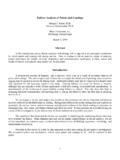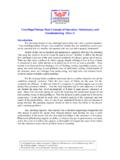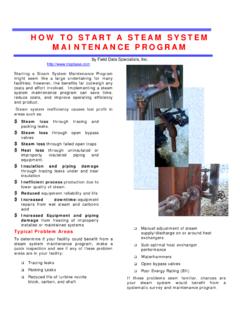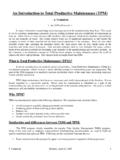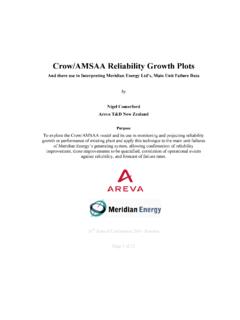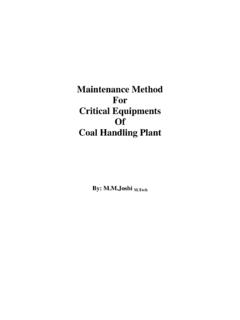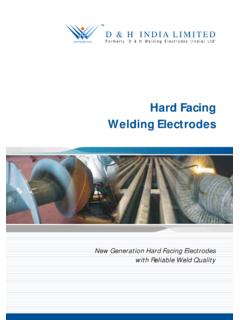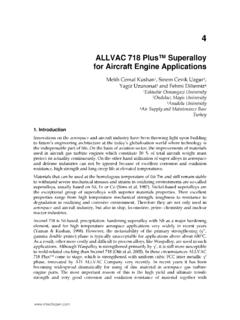Transcription of Inspection and Welding Repairs of Pressure Vessels
1 Inspection and Welding Repairs of Pressure Vessels BY S. V. GUPTE , ASNT LEVEL III - RT,MT,PT,VT Pressure VESSEL INSPECTOR (API 510), (CCOE) PAINT AND COATING INSPECTOR (NACE INDIA) LEAD AUDITOR QMS ABSTRACTS Repairs are required for Pressure Vessels in order to restore its original / intended operating condition, safe operation and to prolong trouble free service life. The vessel condition deteriorate due to various factors mainly Mechanical Problems, Process Related Problems and Corrosion Problems. Repairs are required to be planned and carried out under the strict supervision and control of a competent Inspector. The paper briefs the various steps involved in: Decision making for the Repairs depending on location and nature of defect within the Pressure vessel as per ASME as well as API 510 code. Welding procedure qualifications . Materials and Welding consumables to be used for procedure qualification.
2 Requirements and limitations of controlled deposition Welding as an alternative to PWHT, or where Impact testing is a requirement . By using preheating methods where Impact testing is not a requirement . Method of Temper bead techniques . Method of Half bead technique . NDT that can be employed before, during and after Welding . Necessity of PWHT and Hydrostatic tests . Repairs and precautions during overlay weld Repairs . Methods and precautions to be taken during alterations and re-rating of Pressure Vessels . Aspects of reporting and re- Inspection . The Paper aims to brief the interested audience involved in Welding Inspection and Repairs of Pressure Vessels that can be conducted in Shut downs within Chemical, Refinery, Petrochemicals and Fertilizer industries; various methods of weld Repairs and related activities such as testing after Welding .
3 Key Words: Owner user: Owner or a user organization of the equipment. Repairer: The agency or organization, appointed by the owner user for Repairs of the equipment. Inspector: A competent Inspection engineer having full knowledge of the Pressure vessel construction, in-service Inspection Welding etc. Designer: A competent Pressure Vessel Design Engineer. Code: Code or standard used for design / construction and Inspection of Pressure vessel. NDT inspector: A competent NDT inspector having thorough knowledge and experience of NDT techniques involved in Construction and Repairs . PWHT: Post weld Heat Treatment given to the Pressure vessel during construction or Repairs . Introduction: Repair and maintenance of parts and components is a major activity in any process industry.
4 Repair Welding can be carried out as a logical procedure that ensures the part is usable and safe. If Repairs are done with proper care or precautions, it can avoid premature failures, large warranty claims, safety of property and personnel and result in satisfied customers. Failures of Pressure Vessels are still observed, which result in a costly down time of production and product losses also sometimes it results in environmental hazards and unsafe working conditions or disasters. Every owner user wants to extract highest possible safe service life from equipment. The Pressure vessel Repairs also cannot be an exception this philosophy. Modern Pressure Vessels are constructed in accordance to a recognized code and established fabrication and Welding practice. Method of Inspection and decision for Repairs . Pressure Vessels are designed to any recognized code of design and construction.
5 We must under stand that the design thickness can be considerably lower than the actual Fabricated . During design itself corrosion allowance is added in the base metal thickness and the manufacturer fabrication chooses the next available thickness. Thereby we have a excess thickness available for the service which result in a considerably lower operating stress value. Steps involved in the decision making for Repairs . Operating conditions, Inspection history, Material of construction of Pressure vessel . Reasons for failure . Location of the damaged area by visual Inspection and evaluation by NDTs. Re-evaluate the need for Repairs (Back to design calculations). Repair Methods, (For Pressure retaining parts) . Preparation of repair procedures. Replacement of major components. Operating conditions, Inspection history, Material of construction of Pressure vessel: A careful study of the operating parameters and Inspection history and properly maintained internal Inspection reports, materials of construction, its behavior with the process fluid, Welding techniques used during construction, design consideration etc, also gives an adequate confidence level about the use of Pressure vessel.
6 Such information is also useful for making the repair decision. Carefully selected material of construction and the fabrication procedures, Welding procedures as well as Inspection and certification by the competent Inspection authorities during fabrication stage, always intend to give such information. Reasons for failures: Undesirable premature failures can occur due to any one or more of the following reasons . Faulty design, faulty workmanship, wrongly selected material of construction, wrong Welding techniques such premature failures generally occur in an early service period, where as the normal service failures are attributed to corrosion, changes in the working parameters, operation of the vessel for which it is not designed, impurities in the operating fluids, metallurgical changes in the base metal etc.
7 Once the damage is identified the Pressure Vessels must be thoroughly inspected to evaluate the extent of damage, need for repair and the repair method. Thorough visual Inspection of the Pressure vessel can be supplemented by a suitable NDT examination, to locate the defects and the extent. Location of the damaged area by visual Inspection and evaluation by NDT. On opening the equipment it is necessary to make it safe for entry as the remaining fluid or fumes of gases could be dangerous for human life. The personnel may be required to stay for internal Inspection there could be possible Repairs where hot work is involved, there fore a safe entry permit from a competent authority from the safety and operation departments. During internal Inspection , some responsible operator should always be accessible to the inspector performing internal Inspection .
8 Such assistance can always be handy for any critical situation. The external surface should be checked for any corrosion below the insulation, obvious leakages, structural attachments, connections, foundations, leak proof tightness of Pressure relief valves etc. The internal surface should be reasonably cleaned so as to visually verify its condition , condition of threaded connections, Flange connections, closures, internalsand damage due to corrosion. Different corrosion problems anticipated are pitting, line corrosion., General uniform corrosion, grooving, Galvanic corrosion, Fatigue, Creep, temperature, Hydrogen attack / Embritterment, Stress corrosion cracking, Inter-granular corrosion, etc. The identified damage can be supplemented by NDT for the extent, where by decision for Repairs can be taken confidently, various NDT possible, are UT thickness measurement, UT scanning, RT, MPI and LPT.
9 Re-evaluate the need for Repairs (Back to design calculations) Based on the NDT results obtained, the same can be verified by the designer and inspector by performing design calculations, to ensure that the remaining thickness is still safe, and whether the Repairs are warranted or not. Based on the remaining thickness corrosion rates are calculated and the MAWP at the available thickness also calculated. If the MAWP required is lower that the calculated MAWP then the Repairs are not warranted provided the owner user is ready to carry out internal Inspection as per next scheduled interval. Location of defect is also important. On base metal away from the weld metal, a monitor thinning can be left unattended. In event there are borderline case the thickness can be recalculated by carrying our full RT and thereby revising the Joint efficiency.
10 Following design considerations are reviewed during re-evaluation Patch Repairs welded by fillet Welding can be used on temporary basis. Such Repairs shall be checked and verified by the design Engineer. The same should be replaced with permanent measure at the next available maintenance opportunity. A fully encirclement lap joint may be considered as a permanent repair method. Such full encirclement patches shall also be designed to meet the code requirements. Minimum thickness observed shall be evaluated for MAWP and the corrosion rate, so as to decide the next Inspection interval. Location of localized corrosion, such as on the base metal, away from L seam, Away from C seam, on the weld joints, on crown portion of the head, etc. thereby, comparing the original design requirement. by carrying out L seam Radiography, the joint efficiency can be revised to 1 and the remaining thickness acceptable can be revised.
